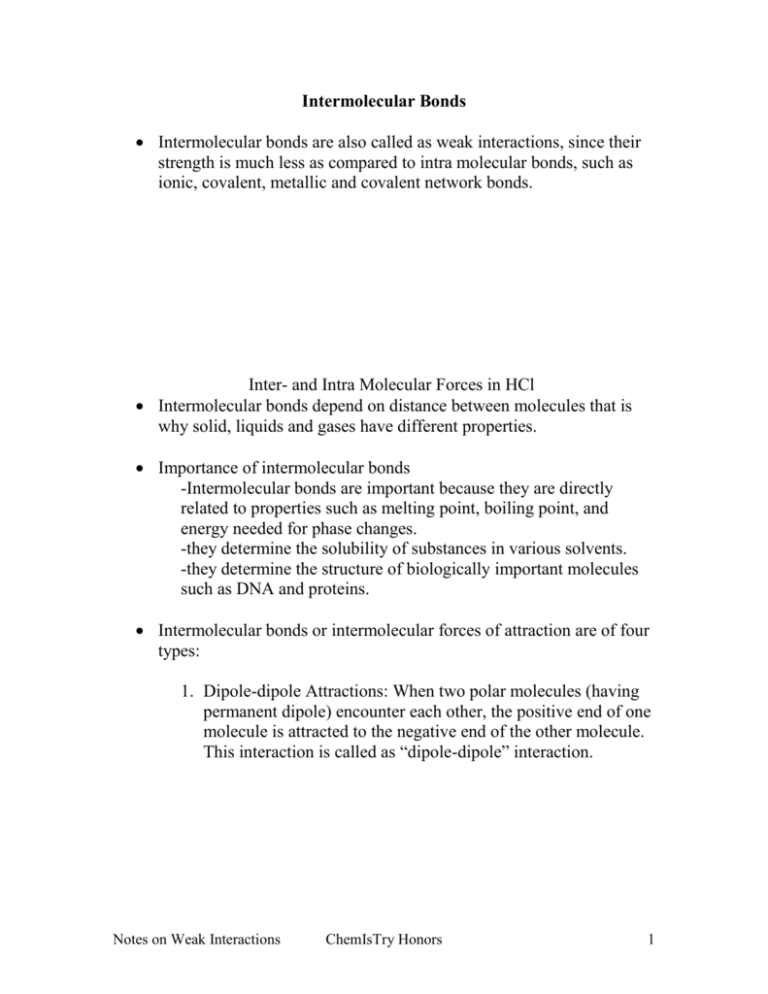Intermolecular Bonds - mvhs
advertisement

Intermolecular Bonds Intermolecular bonds are also called as weak interactions, since their strength is much less as compared to intra molecular bonds, such as ionic, covalent, metallic and covalent network bonds. Inter- and Intra Molecular Forces in HCl Intermolecular bonds depend on distance between molecules that is why solid, liquids and gases have different properties. Importance of intermolecular bonds -Intermolecular bonds are important because they are directly related to properties such as melting point, boiling point, and energy needed for phase changes. -they determine the solubility of substances in various solvents. -they determine the structure of biologically important molecules such as DNA and proteins. Intermolecular bonds or intermolecular forces of attraction are of four types: 1. Dipole-dipole Attractions: When two polar molecules (having permanent dipole) encounter each other, the positive end of one molecule is attracted to the negative end of the other molecule. This interaction is called as “dipole-dipole” interaction. Notes on Weak Interactions ChemIsTry Honors 1 Dipole-Dipole Interaction between two HCl molecules (http://www.800mainstreet.com/08/0008-0012interforce.html) 2. Hydrogen Bonds: When hydrogen is bonded to F,O or N (highly electronegative atom), due to large electronegativity differences, the opposite ends of such molecules attract each other and it is called as hydrogen bond. Hydrogen Bonds between Water Molecules (http://www.webchem.net/notes/chemical_bonding /dipoledipole.htm) 3. London Dispersion Forces (LDFs): Due to the constant movement of electrons in the electron cloud around the atoms, electron density can be asymmetrical causing the atom to have “instantaneous dipole”. These momentary induced dipole interactions are called as London Dispersion Forces. These Notes on Weak Interactions ChemIsTry Honors 2 occur in non polar molecules and increase with the size of the atom (more electrons). London Dispersion Forces as a result of Induced Dipole LDFs increase with the size of atoms because of larger number of electrons in bigger atoms (http://www.chemguide.co.uk/atoms/bonding/vdw.html#top) 4. Ion-dipole Interactions: Ions interact with the charged ends of the polar molecules to give ion-dipole interactions. LDFs and dipole-dipole interactions are collectively called as “Van Der Waals forces”. Several types of intermolecular forces may be at work in a single type of molecule. The strength of intermolecular bonds is in the order Ion-dipole> dipole-dipole (including H-bond) > dipole/induced dipole LDFs Notes on Weak Interactions ChemIsTry Honors 3 Type of Interaction Ion-Dipole Summary of Intermolecular Forces Forces Responsible for Approximate Example Interaction Energy (kJ/mol) Ion charge, magnitude 40-600 Na+…..H2O of dipole Dipoledipole Dipole Moment (depends upon atom electro negativities and molecular structure) 20-30 H2O, HCl Hydrogen Bonding London Dispersion Forces Very polar X—H bond (where X= F,N,O) Polarizability 5-30 H2O… H2O 0.05-40 I2………I2 Notes on Weak Interactions ChemIsTry Honors 4 Summary of Types of Intermolecular Forces (http://www.miramar.sdccd.cc.ca.us/faculty/fgarces/ChemProj/Ch201_Sp20 01/Margarita/IMF.htm) Notes on Weak Interactions ChemIsTry Honors 5 Lewis Structures Lewis structures are used to depict bonding pairs and lone pairs of electron in the molecule. Step 1 Total number of valence electrons in the system: Sum the number of valence electrons on all the atoms . Add the total negative charge if you have an anion. Subtract the charge if you have a cation. Example: CO32- Step 4 Number of electrons if each atom is to be happy: Atoms in our example will need 8 e (octet rule) or 2 e ( hydrogen). So, for the ex. Step 3 Calculate number of bonds in the system: Covalent bonds are made by sharing of e. You need 32 and you have 24. You are 8 e deficient. If you make 4 bonds ( with 2 e per bond) , you will make up the deficiency. Therefore, # of bonds= ( e in step 2- e in step 1)/2 =(32-24)/2= 4 bonds Notes on Weak Interactions ChemIsTry Honors 6 Step 4 Draw the structure: The central atom is C ( usually the atom with least electro negativity will be in the center). The oxygens surround it . Because there are four bonds and only three atoms, there will be one double bond. Step 5 Double check your answer by counting total number of electrons. Draw the Lewis structures for the following using above steps. Show work! A.Cl2 B. CH2Cl2 Notes on Weak Interactions ChemIsTry Honors 7 3. NH3 Exceptions to octet rule: ICl3 Resonance: When a molecule has more than one Lewis structures, it is said to have resonance. Ex. SCN- Notes on Weak Interactions ChemIsTry Honors 8









